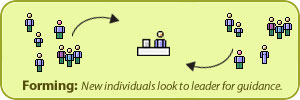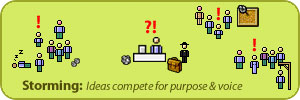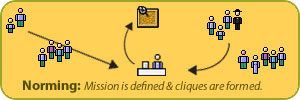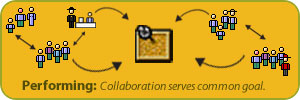This exercise is for Social & Community Managers seeking to start, build and grow their online communities.
Be sure to read the Online Community Lifecycle first!
Stage 1: Forming
Reflection: Online Community Formation

You probably have a good idea about how you’d like to steer the early stages of your web community. Ponder these questions to see if you’re on track and where you might adjust.
Have you defined how your community will operate? Have you published forum rules or comment guidelines? Do you have a privacy policy? Do you have a plan for dealing with spam, trolls and other abusive elements?
Will you allow members to self-promote in early stages? Will your leaders and mods be able to distinguish between natural self-promotion and spam posts?
What attributes reveal your management style? Approachable? Hands off?
Which best describes your approach in forming your group?
» Ready. Aim. Fire.
» Ready. Fire. Aim.
» Ready. Aim. Aim. Aim. Aim.
Who do you know that counterbalances your style and approach? How can they help?
Are you participating in your community? What are you doing to foster group participation? What are you doing that inhibits participation?
Who is emerging as a potential leader in your community? Are there any brand evangelists? Consistent contributors? Natural mediators? Do they get along well with others?
Stage 2: Storming
Reflection: Online Community Growth

As your community vision extends to others, you inherently sacrifice messaging control. Learn from the mistakes of others, and look at the many brands handling this change successfully. Read these questions to help articulate new and persistent problems and suggest possible actions you can take.
How do you welcome new members to your community? What would a new member experience when they join your group?
Do you have infighting among members of your group? Is it healthy debate or destructive bomb-throwing?
Do you have a Troll Watch List? How will you deal with troublemakers? Which is an appropriate course of action: a public rebuke? A gentle reminder of the rules? Or do you cut to the bone and ban them from the community?
Do you have arguments spilling over from other communities on the Internet? Can you find resolution from past history? Do you accept personality clashes as inevitable?
Do “know-it-alls” squash discussion? Are they truly knowledgeable, but lack interpersonal soft skills? Can you help them add value without pissing everyone off? Or are they just jerks? Can you call in support from senior members to chastise, clarify, defend or attack?
How do you oversee member contributions? Are avatars offensive? Are you overrun with spam or offensive material? Do you invite self-policing or do you have a team of responders actively patrolling for issues or both? Do you have clear path to moderators so members can notify you of problems? Are you aware of technologies that can help you control unwanted and malicious material?
Do you have strong diplomats that value peacekeeping over healthy debate and disagreement? Are they allowing an argument enough time to play itself out? Do they send fighters to their corners too quickly?
How is your leadership personality? Can you be a bit overbearing or needy at times? Too timid? How do you respond to the ideas of others? Do you have a “brain trust” that can give you honest feedback of your performance?
Stage 3: Norming
Reflection: Habit & Tone in Your Online Community

As your community matures, you will recognize healthy attachment among its members. Your community may operate fine in this stage with minor maintenance and attention. Or you might want to tighten cooperation and press for higher performance.
Can you identify sub-groups within your community? Which are good, bad or ambiguous to your goals & objectives?
Do you have any individuals that tend to cut across cliques or rise above the fray? Might they become leaders, moderators or brand evangelists for you?
What tools and methods can every member hook into? What areas need stronger collaboration?
What good habits does your group have? How can you foster them?
What bad habits does your group have? What actions or lack of action leads to those habits? What attitudes, beliefs and past “baggage” contribute to those ongoing actions?
What ideas and practices are deeply ingrained in your community? Do they really serve the purpose? Can you identify any that are harmful or inhibit performance? Are you part of the echo chamber or do you have enough distance to recognize it?
Are you transitioning from a role of director to a role of working supervisor? Are others assuming roles of leadership?
Do you need to return to a new Forming or Storming stage to shake up your community? Who can you recruit to help?
Stage 4: Performing
Reflection: Sustaining High Performance

Congratulations if your community has achieved a level of high performance. Take some time to think about how you can keep it going.
Is your software keeping pace with your level of community activity?
Which social networks target your membership demographic or psychographic? Where else do your members hang out? Can you forge mutually beneficial partnerships?
Can use social media networks and user generated content platforms to expand services to existing members? Can you use these tools to boost membership?
Can you leverage Ning’s “viral expansion loop” to accelerate growth?
What tactics do you see working in other high performing communities?
Post Mortem: Transforming and Mourning
Reflection: Changes and Death of an Online Community
Your community may be on the verge of temporary or permanent transition. Consider these issues to decide if you should embrace change or pull the plug.
Have key influencers or core leaders left the group?
Are you facing burnout? Do you have time to continue leading?
Are you stuck in a perpetual Storming stage? Would it make sense to transition back to Forming or press on to Norming?
Who could potentially take over community management? Is there a stand-out leader or sub-group?
Is your advertising campaign approaching EOL? Is the community still flourishing? Do long-tail benefits justify continued community support, even without actively promoting it?
How can your community celebrate its accomplishments? Who deserves acknowledgment?
Final Thoughts
Community Managers that want to work on their community, and less time in it should study Tucker’s model of group dynamics in the context of a Social Community Lifecycle.